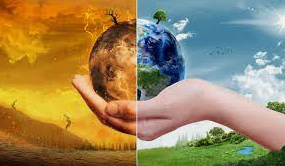"Global warming is a huge burden that we have created and it affects us all. This article is about how global warming is affecting flora and fauna" --mariah rico, 6th grade
Climate change can alter the life cycles of plants and animals. For example, as temperatures rise, many plants grow and bloom earlier in the spring and survive longer in the Fall. Animals like Caribou (reindeer), arctic foxes, toads, polar bears, penguins, gray wolves, tree swallows, painted turtles, and salmon are waking from hibernation sooner or migrating at different times.
Global warming is caused by carbon dioxide and other air pollutants collected in the atmosphere and absorbed by sunlight and solar radiation that have bounced off the Earth's surface. Avoiding dangerous climate change means we need to stop using fossil fuels worldwide, and also stop using things that are dangerous for the Earth.
Global warming is increasing the frequency and intensity of some types of extreme weather. Such as causing more rain to fall through heavy downpours in places like Germany, Pittsburgh, Japan, Philippines, and Madagascar, to name a few.. There are also longer dry periods between rainfalls. This coupled with more evaporation due to higher temperatures, intensifies drought. It is melting ice caps and making cold places warmer, making it inhabitable for animals who are used to cold weather. Warmer water temperatures will cause declines in populations for trout and other species that need cold water to survive. Warmer ocean temperatures have already hurt massive places full of coral, because the coral can’t live in warm water.
The article Earth Talk says that “Global warming, scientists say, is responsible not only for shrinking ice caps but also for a surge in extreme weather that is causing heat waves, forest fires, and droughts.” Earth Talk continues on to say, “The polar bear standing on a chunk of shrinking ice, apparently stranded, has become a familiar image, a symbol of the devastating effects of climate change.” Animals who live in the North Pole or in icey cold places are struggling to survive without the ice and with warmer temperatures.
The article made by the NEM (The National Academies Of Sciences, Engineering, and Medicine), says, “A warmer and more moist atmosphere over the oceans makes it likely that the strongest hurricanes will be more intense, produce more rainfall, and possibly be larger. In addition, global warming causes sea level to rise, which increases the amount of seawater, along with more rainfall, that is pushed on to shore during coastal storms. That seawater, along with more rainfall, can result in destructive flooding.”
The article continues, “While global warming is likely making hurricanes more intense, scientists don’t know yet if global warming is increasing the number of hurricanes each year. The effect of global warming on the frequency, intensity, size, and speed of hurricanes remains a subject of scientific research.”
Global warming is caused by carbon dioxide and other air pollutants collected in the atmosphere and absorbed by sunlight and solar radiation that have bounced off the Earth's surface. Avoiding dangerous climate change means we need to stop using fossil fuels worldwide, and also stop using things that are dangerous for the Earth.
Global warming is increasing the frequency and intensity of some types of extreme weather. Such as causing more rain to fall through heavy downpours in places like Germany, Pittsburgh, Japan, Philippines, and Madagascar, to name a few.. There are also longer dry periods between rainfalls. This coupled with more evaporation due to higher temperatures, intensifies drought. It is melting ice caps and making cold places warmer, making it inhabitable for animals who are used to cold weather. Warmer water temperatures will cause declines in populations for trout and other species that need cold water to survive. Warmer ocean temperatures have already hurt massive places full of coral, because the coral can’t live in warm water.
The article Earth Talk says that “Global warming, scientists say, is responsible not only for shrinking ice caps but also for a surge in extreme weather that is causing heat waves, forest fires, and droughts.” Earth Talk continues on to say, “The polar bear standing on a chunk of shrinking ice, apparently stranded, has become a familiar image, a symbol of the devastating effects of climate change.” Animals who live in the North Pole or in icey cold places are struggling to survive without the ice and with warmer temperatures.
The article made by the NEM (The National Academies Of Sciences, Engineering, and Medicine), says, “A warmer and more moist atmosphere over the oceans makes it likely that the strongest hurricanes will be more intense, produce more rainfall, and possibly be larger. In addition, global warming causes sea level to rise, which increases the amount of seawater, along with more rainfall, that is pushed on to shore during coastal storms. That seawater, along with more rainfall, can result in destructive flooding.”
The article continues, “While global warming is likely making hurricanes more intense, scientists don’t know yet if global warming is increasing the number of hurricanes each year. The effect of global warming on the frequency, intensity, size, and speed of hurricanes remains a subject of scientific research.”


